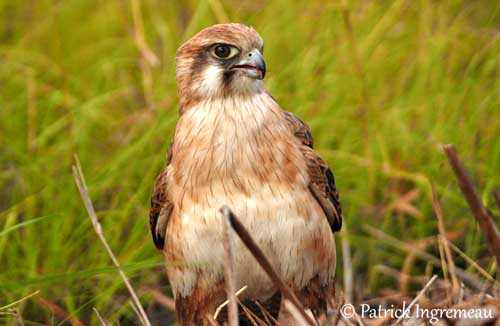
Fr: Faucon bérigora
All : Habichtfalke
Esp : Halcón Berigora
Ital : Falco bruno
Nd: Grote Bruine Valk
Sd: Brunfalk
Photographer:
Patrick Ingremeau
TAMANDUA
Text by Nicole Bouglouan
Sources:
HANDBOOK OF THE BIRDS OF THE WORLD Vol 2 by Josep del Hoyo-Andrew Elliot-Jordi Sargatal - Lynx Edicions - ISBN: 8487334156
BirdLife International (BirdLife International)
Birds in backyards (Birds Australia and Australian Museum)
Wikipedia, the free encyclopaedia
Brown Falcon
Falco berigora
Falconiforme Order – Falconidae Family
BIOMETRICS:
Length: 41-51 cm
Wingspan: 89-109 cm
Weight: M: 316-590 g – F: 430-860 g
DESCRIPTION:
The Brown Falcon or Brown Hawk has slightly different hunting behaviour regarding other falcons. This species occurs in both light and dark forms, with some intermediates.
The adult may vary in colour, from pale reddish-brown with rufous thighs, to dark form with barred underwing and tail.
Usually, the upperparts are dark brown and the underparts mostly pale buff or cream.
We can see the typical dark stripe below the eye, and head sides are brown, whereas chin is white.
There are some differences between the falcons from the tropical north which are very dark, with paler face and undertail, and the birds from Central Australia which are paler overall. The SW birds are small and rufous.

The female is larger than male, and both sexes are long-legged.
The hooked bill is pale blue-grey with blackish tip. The eyes are brown with pale grey eyering. Legs and feet are greyish.
The juvenile resembles dark adults, but with indistinct barring on tail, and buff-yellow face, throat and nape.
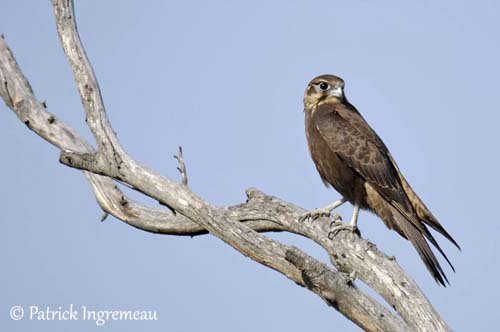
Several subspecies have been identified in the past, but now, only three are recognized:
F.b. novaeguineae is found in C and E New Guinea and coastal N Australia.
F.b. berigora occurs in E, C and N Australia and Tasmania.
F.b. occidentalis is found in SW and CW Australia.
VOICE: SOUNDS BY XENO-CANTO
The Brown Falcon frequently gives loud cackles, but it also produces raucous crowing, chatters and screeches, and quieter clucks and croaks.
HABITAT:
The Brown Falcon frequents forests and adjacent grasslands. It is mainly seen in grassy or cultivated areas, scrub and savanna with scattered trees. It can be found in open woodland and desert. It is visible from sea-level up to 2000 metres of elevation, sometimes higher in New Guinea.
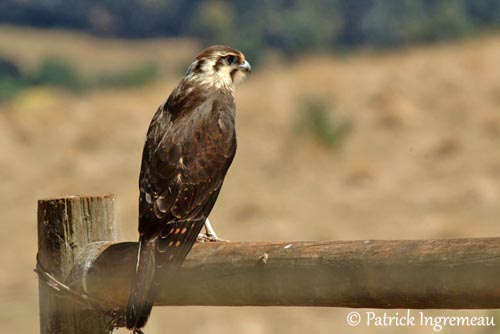
RANGE:
The Brown Falcon is found throughout Australia and Tasmania. Adults are usually sedentary with only some local movements to winter areas. However, juveniles may disperse and can be partially migratory within Australia. The southern populations winter to North, and may reach tropical Australia and New Guinea.
There are sometimes irruptions due to abundant food sources.
BEHAVIOUR:
The Brown Falcon, like other Falconidae, takes several types of preys such as mammals, birds, reptiles, amphibians, arthropods and carrion.
This falcon is often seen alone, hunting from exposed perch. Once the prey is detected, it swoops down and grasps it with its talons. Then, it kills the prey by biting it to the spine with its well adapted bill. Sometimes, the attack may become a short chase.
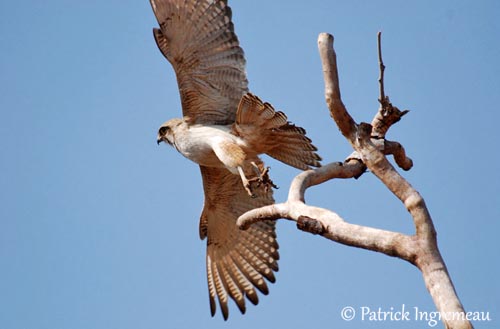
It may sometimes hunt by hovering, or by performing low, fast flight, or by soaring and gliding often at great heights.
The large insects are pursued on foot on the ground. It follows fires, livestock and agricultural machinery for flushed preys. Both mates may hunt together and co-operatively. They also steal preys from other raptors.
At the beginning of the breeding season, both mates perform typical flight displays. Pair-bonds usually last for life, and the territory is maintained and strongly defended all year round.
The Brown Falcon is solitary nester, and often uses an abandoned stick nest placed in tall tree, or occasionally in hollow tree. The nest is often reused year after year.
FLIGHT:
The Brown Falcon is a good flier when hunting or displaying. However, its flight is relatively slow, with wingbeats interspersed with glides on wings held in shallow V-shape.
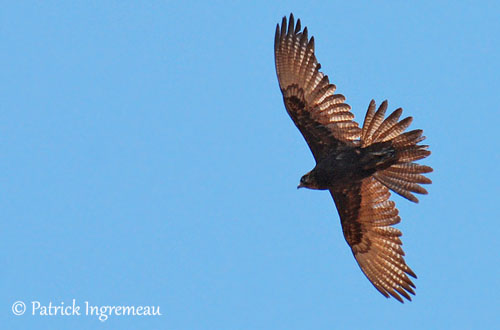
REPRODUCTION:
The breeding season takes place between April and September in North, and between August and October in South.
The Brown Falcon breeds solitary and uses an old stick nest of other bird of prey or Corvidae. They may add some materials such as pieces of bark and leafy twigs.
The female lays 2-3 eggs, and incubates during 31-36 days. She is fed by the male during this period, and the male brings preys at nest for the chicks too, but the female feeds them with this food.
The juveniles leave the nest about 36 to 42 days after hatching, but they still depend on parents for 6-10 weeks more after fledging.
The young male may breed at three years, whereas the young female is sexually mature at two years old.
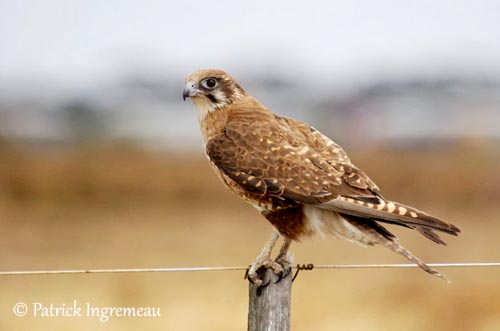
DIET:
The Brown Falcon hunts from perch or by hovering and gliding over the ground. It feeds on small mammals such as mice, rats and rabbits, reptiles such as lizards and snakes, large insects such as caterpillars, grasshoppers, crickets and beetles, fish, small birds and farm chicken, amphibians and carrion.
PROTECTION / THREATS / STATUS:
The Brown Falcon is common and widespread in its range. This species benefits from several agricultural activities, but it may be shot and trapped.
However, the Brown Falcon is not currently threatened.
